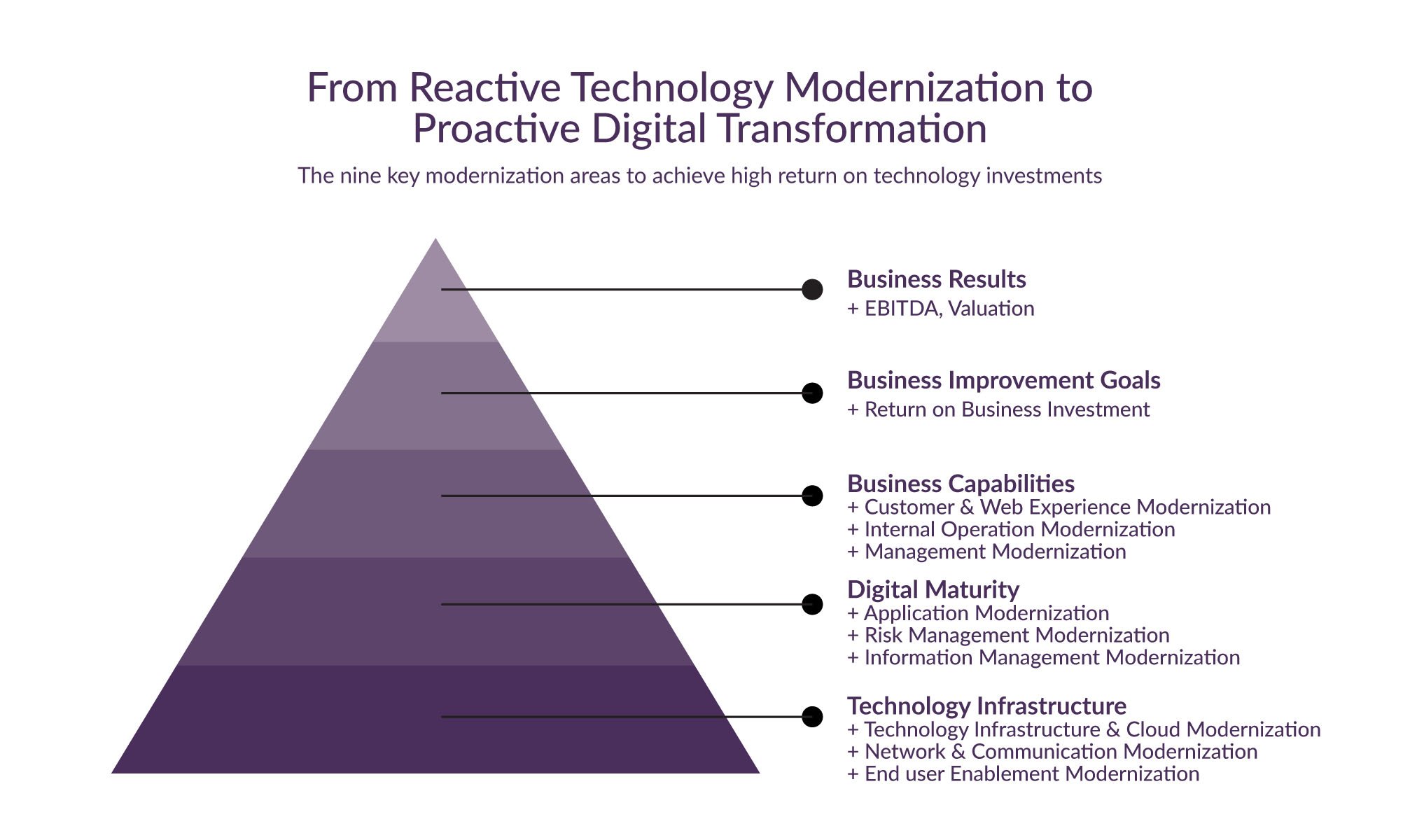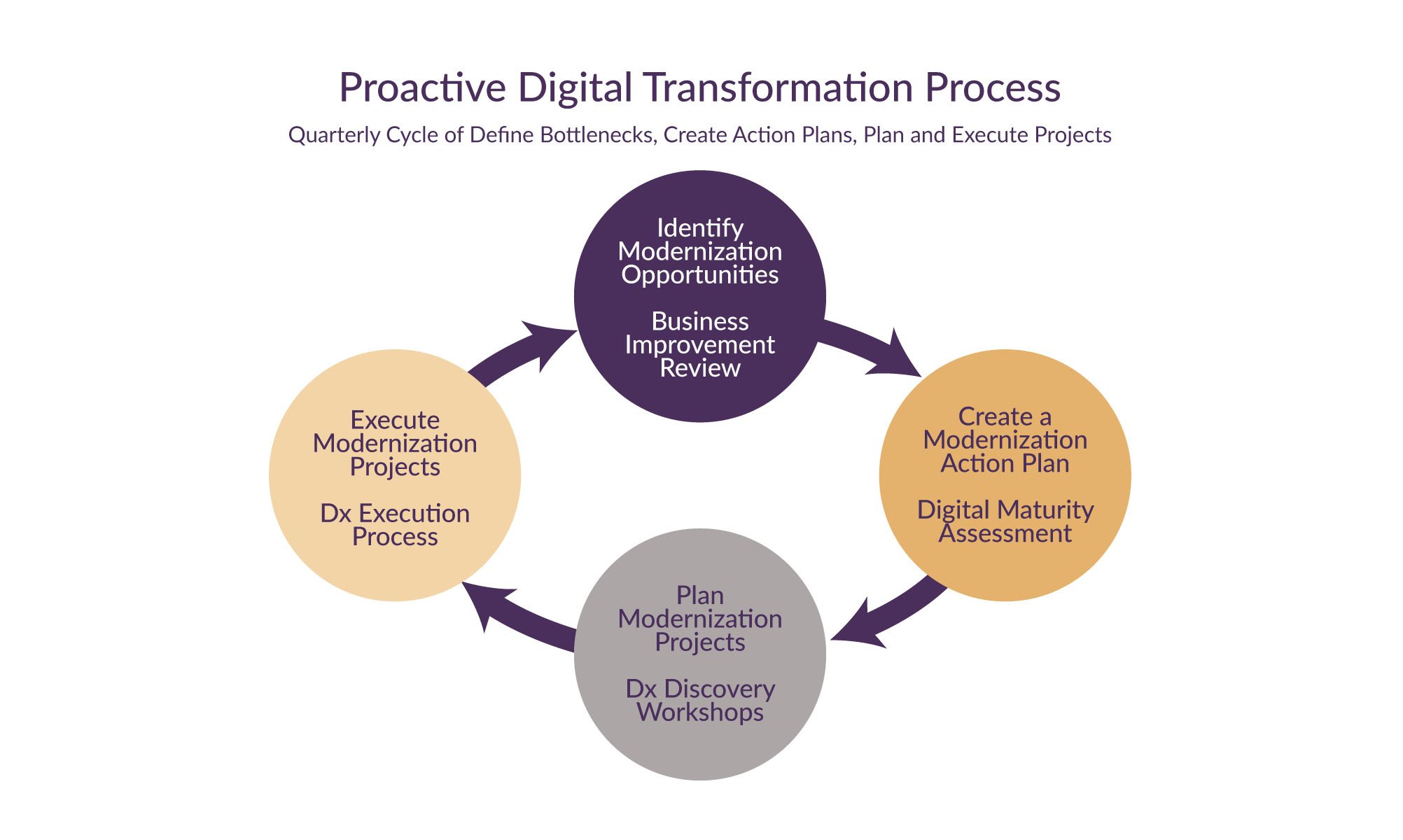Too often small and medium sized organizations spend money on technology modernization reactively, without planned alignment with their business goals. They invest in modernization projects like replacing old Office Applications with Microsoft 365, expanding from email and calendar to Microsoft Teams, decommissioning servers, migrating to the cloud and so on. That leads to overspending in spite of the small budget they have, questionable business results and very little return on technology investments.
The reactive approach is the cause of their problems.
- change in market conditions (competitor has a better, website we need one too)
- internal business improvement opportunities (a new CRM would help on sales)
- security concerns (compliance requirements)
- aging infrastructure (the server was down and we need faster internal network)
They try to add pieces from random puzzles hoping a meaningful picture will come out.
The solution is simpler than it might seem. The goal is to turn reactive strategic technology modernization projects into proactive digital transformation.
In other words, seeing a complete picture first and adding the right pieces from a single puzzle, one piece at a time.
- Proactive Digital Transformation Areas
The first step is to understand the complete picture and see which modernization opportunities can yield the best return on investment.
There are three main areas of modernization: Technology Infrastructure, Digital Maturity and Business Capabilities. In each main area there are three core components to look for. That means business owners need to prioritize and make decisions in nine areas.

Modernization to improve Technology Capabilities
These projects intend to improve technology capabilities or the base of the technology infrastructure.
- Technology Infrastructure and Cloud modernization – Modernization of storage, data centers, server infrastructure and cloud
- Network and Communication modernization – Modernization of network infrastructure, firewalls, switches and communication devices
- End user enablement modernization – Modernization of workstations, laptops, tablets, smart phones and related operating systems
These modernization projects are usually managed by the CIO and the internal IT team or the vCIO and the managed service provider. Usually, a Technology Strategy Roadmap is governing these projects, so the business owners should be able to budget and see what’s coming in advance.
Modernization to improve Digital Maturity
These projects intend to improve digital maturity and capabilities in order to use the underlying infrastructure.
- Application management – Modernization of core office applications such as Microsoft Office 365, Line of business applications
- Risk management – Modernization of policy and compliance, identity management and cybersecurity awareness
- Information management – Modernization of data management, analytics, reports and access to various insights
These modernization projects are usually not managed by anyone. The CIO and internal teams or the vCIO and managed service provider execute the technology projects but they fail to adopt the technologies across the organization. The well performing organizations have a dedicated role between the business and the technology team.
Modernization to improve Business Capabilities
These projects intend to improve business capabilities such as finance, operations, marketing, sales, service, HR or management.
- Customer & Web Experience modernization – Modernization of website, social media presence, sales enablement, support processes and customer feedback
- Internal Operation modernization – Modernization of line of business applications, processes, analytics and project management
- Management modernization – Modernization of planning, execution, employee development, delegation and teamwork
These modernization projects are typically led by the business units. The problem is that these leaders usually have less experience leading technology related projects. Smart organizations have a dedicated role to coach and help the business leaders through these business-technology projects.
- Proactive Digital Transformation Process
Once they’ve seen the map and all the different modernization areas, they need a simple and repeatable process to identify opportunities and complete modernization projects successfully. That results in less work and higher return on any technology investment.

- Identify Modernization Opportunities
The first step is to identify modernization opportunities very quickly in order to identify the major opportunities in all areas. This is typically a 60-minute session called Business Improvement Review
- Create a Modernization Action Plan
The second step is to create a strategic action plan for modernization that helps to make strategic decisions that lead to proactive measures. This is a process with four 90–minute sessions called Digital Maturity Assessment leading to a comprehensive 6 to 24 month roadmap of modernization projects.
- Plan Modernization Projects
Most technology-business projects fail because of a lack of planning and coping. Therefore the third step is to start scoping and planning the individual projects. For each project this is five 60–minute sessions called Digital Transformation Discovery Workshops. These workshops produce project visions, timelines and execution plans.
- Execute Modernization Projects
Once we have the plans we need somebody who has time and most likely skills to lead these projects. It can be the business owner, a division leader or a consultant from outside. The process has to be repeatable and followed by all in order to succeed. Digital Transformation Execution Process is a set of quarterly, monthly and weekly best practices to do in order to ensure the success of those projects.
On a bumper sticker:
Organizations are modernizing technologies by reacting to market changes, aging technology challenges and business opportunities. These disjointed and reactive modernization projects don’t yield the needed return on investments. The solution for small and mid–size businesses is to prioritize the modernization projects and execute them under a proactive digital transformation initiative.
Want to discuss your digital transformation project?
Tags:
Digital Transformation
November 3, 2022
